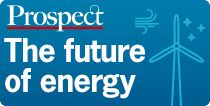Find Prospect's full report, "The Future of Energy" here
Chris O’Keefe explains how Toyota is addressing environmental and energy challenges involved in the production of cars and the impact of vehicles on the road. He talks, too, about a future featuring automated cars.
Jon Bernstein (JB): What does sustainability mean to Toyota?
Chris O’Keefe (CO): In October 2015 we launched the Toyota Environmental Challenge 2050, six internal targets set by us, with the specific aim of helping create a sustainable society. It gives direction to everyone who works for our company and our suppliers. There are six points to the challenge:
JB: How do you minimise the energy you use in the manufacturing process?
CO: Our efforts are based on two pillars. First, making our production plants simpler, slimmer and less energy-intensive. Second, increasing the use of renewable powers such as solar and wind, combined with direct use of hydrogen.
JB: How do you minimise the environmental impact of your vehicles?
CO: We must address the issues associated with the growth in vehicle numbers and the impact this has on the environment. Toyota is doing this primarily by embracing diverse energy sources, developing efficient and low-emission vehicles and driving change by making these vehicles popular with customers. This is why Toyota introduced hybrid technology in 1997. But it takes time for future technologies to have significant market impact.
It took us almost 10 years to pass one million hybrid sales globally but only nine months to sell the most recent million. Today we are selling between 1.3 and 1.4m hybrids a year.
For Toyota, hybrid will remain our core technology as we believe it is the best way of optimising efficiency.
JB: And how will you minimise
impact tomorrow?
CO: It won’t be down to just one technology. In the future, a range of solutions will be needed to meet different customer needs. All will have hybrid at their core but each one will be able to use different energy sources to suit how and where the vehicle will be used.
So we foresee electric vehicles for short distance and “last mile mobility,” hybrid and plug-in hybrid for all-round usage and hydrogen fuel cell for medium to long-range zero emissions driving.
Both electricity and hydrogen will be vital. Setting these technologies as competitors rather than as complementary future technologies is a misconception.
JB: What role will hydrogen have as an energy of the future?
CO: Toyota has been researching, developing and refining our hydrogen fuel cell systems since 1992. The result? The Mirai, our first fuel cell production model.
Hydrogen is a very good source of power with the potential to answer some of the most important environmental challenges we are facing—climate change, air quality and energy security.
Part of hydrogen’s appeal is that it can be produced from a variety of sources. Hydrogen can also act as a buffer to balance supply and demand for renewable energy sources, becoming a means of storing generated energy.
JB: What’s the future of mobility?
What role do autonomous vehicles play
in that future?
CO: We want automated driving technologies that let people travel safely, smoothly and freely.
To this end, Toyota has three objectives. First, we want autonomous vehicles to help contribute to the eradication of traffic fatalities. Second, we want to smooth traffic flows, addressing the worst of traffic congestion. Finally, we need to provide mobility for all, including the elderly and handicapped.
You can also receive the full report as a fully designed PDF document by simply entering your email below.
[prosform fields="email,forename,surname" signupcode="Energy" countrycode="GB" redirect="the-future-of-energy-is-yours"]
When you sign up for this free report, you will also join our free Prospect newsletter.
Prospect takes your privacy seriously. We promise never to rent or sell your e-mail address to any third party. You can unsubscribe from the Prospect newsletter at any time
Chris O’Keefe explains how Toyota is addressing environmental and energy challenges involved in the production of cars and the impact of vehicles on the road. He talks, too, about a future featuring automated cars.
Jon Bernstein (JB): What does sustainability mean to Toyota?
Chris O’Keefe (CO): In October 2015 we launched the Toyota Environmental Challenge 2050, six internal targets set by us, with the specific aim of helping create a sustainable society. It gives direction to everyone who works for our company and our suppliers. There are six points to the challenge:
- Reduce our new vehicle CO2/km emissions by 90 per cent by 2050 against a 2010 benchmark, using hybrids, plug-in hybrids, electric vehicles, and fuel cell vehicles as key contributors to this objective.
- Challenge zero CO2 emissions from the vehicle lifecycle, including materials, parts and manufacturing.
- Challenge zero CO2 emissions related to equipment and process energy use during manufacturing.
- Drastically reduce water usage.
- Establish a recycling-based society.
- Establish a future society in harmony with nature.
JB: How do you minimise the energy you use in the manufacturing process?
CO: Our efforts are based on two pillars. First, making our production plants simpler, slimmer and less energy-intensive. Second, increasing the use of renewable powers such as solar and wind, combined with direct use of hydrogen.
JB: How do you minimise the environmental impact of your vehicles?
CO: We must address the issues associated with the growth in vehicle numbers and the impact this has on the environment. Toyota is doing this primarily by embracing diverse energy sources, developing efficient and low-emission vehicles and driving change by making these vehicles popular with customers. This is why Toyota introduced hybrid technology in 1997. But it takes time for future technologies to have significant market impact.
It took us almost 10 years to pass one million hybrid sales globally but only nine months to sell the most recent million. Today we are selling between 1.3 and 1.4m hybrids a year.
For Toyota, hybrid will remain our core technology as we believe it is the best way of optimising efficiency.
JB: And how will you minimise
impact tomorrow?
CO: It won’t be down to just one technology. In the future, a range of solutions will be needed to meet different customer needs. All will have hybrid at their core but each one will be able to use different energy sources to suit how and where the vehicle will be used.
So we foresee electric vehicles for short distance and “last mile mobility,” hybrid and plug-in hybrid for all-round usage and hydrogen fuel cell for medium to long-range zero emissions driving.
Both electricity and hydrogen will be vital. Setting these technologies as competitors rather than as complementary future technologies is a misconception.
JB: What role will hydrogen have as an energy of the future?
CO: Toyota has been researching, developing and refining our hydrogen fuel cell systems since 1992. The result? The Mirai, our first fuel cell production model.
Hydrogen is a very good source of power with the potential to answer some of the most important environmental challenges we are facing—climate change, air quality and energy security.
Part of hydrogen’s appeal is that it can be produced from a variety of sources. Hydrogen can also act as a buffer to balance supply and demand for renewable energy sources, becoming a means of storing generated energy.
JB: What’s the future of mobility?
What role do autonomous vehicles play
in that future?
CO: We want automated driving technologies that let people travel safely, smoothly and freely.
To this end, Toyota has three objectives. First, we want autonomous vehicles to help contribute to the eradication of traffic fatalities. Second, we want to smooth traffic flows, addressing the worst of traffic congestion. Finally, we need to provide mobility for all, including the elderly and handicapped.

You can also receive the full report as a fully designed PDF document by simply entering your email below.
[prosform fields="email,forename,surname" signupcode="Energy" countrycode="GB" redirect="the-future-of-energy-is-yours"]
When you sign up for this free report, you will also join our free Prospect newsletter.
Prospect takes your privacy seriously. We promise never to rent or sell your e-mail address to any third party. You can unsubscribe from the Prospect newsletter at any time













